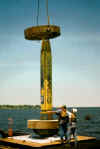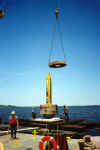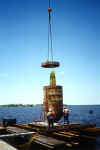Gravel Catching System
Gravel Catching Systems can be used on all sizes of Statnamic devices and are still the most prevalent catching system. This system simply consists of a silo-type container called a gravel structure that is used in conjunction with circular reaction masses. The annular space formed between the reaction masses and the gravel structure is filled with enough gravel so as to fully bury the Statnamic piston and foundation at the completion of the test. During the test, the silencer/reaction mass assembly jumps out of the gravel structure allowing the surrounding gravel to flow into the now vacant space once occuppied by the masses. As the masses decend they fall into a bed of gravel which distributes the impact to the surrounding soil thus protecting the foundation. As with all Statnamic testing, the test is over long before the masses reach the top of their flight. Presently, gravel catching systems are used for all devices larger than 4 MN. Most devices 4 MN and smaller use the Hydraulic catching systems due to the convenience.
Step 1: Secure piston assembly to foundation. Step 2: Install fuel basket before silencer. Step 3: Place silencer (cylinder) on piston. Step 4: Install reaction masses. Step 5: Install reaction masses. (Gravel-filled reaction mass installed in mechanism) Step 6: Install lock-ring to secure reaction masses to the silencer. Step 7: After device is fully assembled, the user is free to lift and lower the full reaction mass assembly using the hydraulic rams in each of the legs. This allows access to the fuel charge, which may now be easily installed. Step 8: Test is performed.
Last Updated December 15, 2006
Copyright © 1999, University of South Florida













